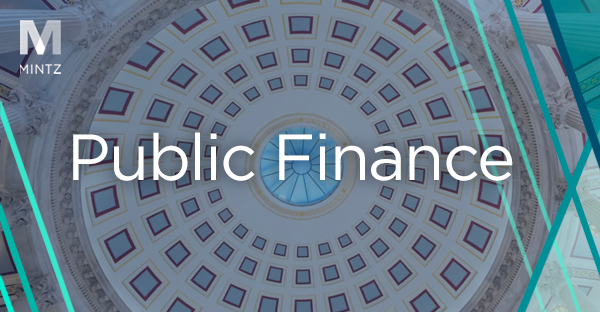
Bankruptcy & Restructuring
Viewpoints
Filter by:
First Circuit Rules That “Incorporation by Reference” of Collateral Description in UCC Financing Statements May Not Perfect Lien
February 14, 2019 | Blog | By William Kannel, Eric Blythe
Tolstoy warned that “if you look for perfection, you’ll never be content”; but Tolstoy wasn’t a bankruptcy lawyer. In the world of secured lending, perfection is paramount. A secured lender that has not properly perfected its lien can lose its collateral and end up with unsecured status if its borrower files bankruptcy.
Read more
The Delaware Bankruptcy Court Grapples With Section 546(e) Post-Merit Management
January 18, 2019 | Blog | By Andrew B. Levin
In its ruling in FTI Consulting, Inc. v. Sweeney (In re Centaur, LLC), the United States Bankruptcy Court for the District of Delaware addressed the Supreme Court’s recent clarification of the scope of Bankruptcy Code Section 546(e)’s “safe harbor” provision, affirming a more narrow interpretation of Section 546(e).
Read more
Supreme Court to Decide Whether Debtors Can Terminate a Licensee’s Rights to Trademarks under License Agreements
December 7, 2018 | Blog | By Tim McKeon
Protecting Creditor Rights in Insolvency Proceedings
August 27, 2018 | Video | By Joseph Dunn
Joe Dunn discusses the importance of creditors taking action to protect their interests when dealing with a distressed company and the tools available to businesses in order to do so.
Read more
Ninth Circuit: No Ulterior Motive, No Bad Faith When Buying Claims to Block Confirmation
July 24, 2018 | Blog
A recent Ninth Circuit Court of Appeals decision provides insight into “bad faith” claims-buying activity; specifically whether a creditor’s purchase of claims for the express purpose of blocking plan confirmation is permissible.
Read more
Non-Debtor Substantive Consolidation: Do Recent Cases Signal a Judicial Preference for State Law Claims?
July 11, 2018 | Blog
It is not unusual for a creditor of a debtor to cry foul that a non-debtor affiliate has substantial assets, but has not joined the bankruptcy.
Read more
Supreme Court Bankruptcy Thoughts: Scope of Safe Harbor and Appellate Review
May 3, 2018 | Blog | By Sarah Ramuta
The Supreme Court recently addressed two bankruptcy issues. In its Merit Management opinion, the Court resolved a circuit split regarding the breadth of the safe harbor provision which protects certain transfers by financial institutions in connection with a securities contract.
Read more
Checking-In: Chapter 9, Chapter 11 or Ineligible?
February 23, 2018 | Blog | By William Kannel
Last week, President Trump unveiled his proposal to fix our nation’s aging infrastructure. While the proposal lauded $1.5 trillion in new spending, it only included $200 billion in federal funding. To bridge this sizable gap, the plan largely relies on public private partnerships (often referred to as P3s) that can use tax-exempt bond financing.
Read more
The First Circuit Casts a Shadow on Sunbeam
February 12, 2018 | Blog | By Amanda M. Blaske
In the recently decided case, Mission Product Holdings, Inc. v. Tempnology, LLC, the United States Court of Appeals for the First Circuit took a hardline position that trademark license rights are not protected in bankruptcy. Bankruptcy Code section 365(n) permits a licensee to continue to use intellectual property even if the debtor rejects the license agreement.
Read more
In Massachusetts, Directors and Investors Acting in their Normal Capacities Do Not Have Personal Liability for Wage Act Violations
February 8, 2018 | Blog
The Massachusetts Supreme Judicial Court recently held that the Massachusetts Wage Act does not impose personal liability on board members or investors acting in their normal capacities.
Read more
Split Third Circuit Holds Transfer By Non-Debtor Cannot Be Fraudulent Transfer
January 31, 2018 | Blog
Refusing to rely on “equitable principles” when interpreting the Delaware Uniform Fraudulent Transfer Act (DUFTA), the Third Circuit (2-1 decision) in Crystallex Int’l Corp. v. Petroleos De Venezuela, S.A, et als. held that a transfer by a non-debtor cannot be a fraudulent transfer.
Read more
A Momentive Decision: Second Circuit Splits with Third Circuit on Make Whole Premiums; Adopts Sixth Circuit’s Two-Step Approach in Selecting an Interest Rate in Chapter 11 Cramdowns
October 25, 2017 | Blog | By Kaitlin R. Walsh
Last week the Second Circuit issued its long-awaited opinion on the appeals of plan confirmation taken by the first lien, 1.5 lien and subordinated noteholders in In re MPM Silicones, LLC (“Momentive”). With one exception, the Court determined that the plan confirmed by the bankruptcy court in September 2014 comports with Chapter 11 of the Bankruptcy Code.
Read more
Bankruptcy Restrictions in Operating Agreement Held Unenforceable
October 4, 2017 | Blog
In In Re Lexington Hospitality Group, LLC, the United States Bankruptcy Court for the Eastern District of Kentucky thwarted a lender’s efforts to control whether its borrower could file bankruptcy.
Read more
Delaware Court Holds that Trademark License Cannot be Assigned Without Consent
August 28, 2017 | Blog
The Delaware bankruptcy court recently decided that a debtor could not assign a trademark license absent the consent of the licensor. The court concluded that federal trademark law and the terms of the license precluded assignment without consent.
Read more
Exculpatory Provisions Under Delaware Law: Say What You Mean And Mean What You Say
July 10, 2017 | Blog
Exculpation provisions in operating agreements must be carefully crafted in order to protect members, managers, directors and officers for breaches of fiduciary duties. In In re Simplexity, LLC, the Chapter 7 trustee sued the former officers and directors (who were also members and/or managers) for failing to act to preserve going concern value and exposing the debtors to WARN Act claims.
Read more
SCOTUS to Settle Circuit Split on Rule Applicable to Recharacterization of Debt to Equity Disputes
July 5, 2017 | Blog | By Kaitlin R. Walsh
The Supreme Court has granted certiorari to decide the question of whether bankruptcy courts should apply state law or a federal rule of decision when determining whether to recharacterize a debt claim as a capital contribution.
Read more
First Circuit Rules that Bankruptcy Court “Retention of Jurisdiction” Provisions Not Enough to Establish Jurisdiction
June 15, 2017 | Blog
It is very common for bankruptcy court orders to provide that the court retains jurisdiction to enforce such orders. Similarly, chapter 11 confirmation orders routinely provide that the bankruptcy court retains jurisdiction over all orders previously entered in the case.
Read more
Supreme Court to Resolve Circuit Split on Scope of 546(e)’s Safe Harbor Provision
May 15, 2017 | Blog | By Kaitlin R. Walsh
Earlier this month, the Supreme Court announced that it will review the scope of Bankruptcy Code section 546(e)’s safe harbor provision. Section 546(e) protects from avoidance those transfers that are made “by or to (or for the benefit of)” a financial institution, except where there is actual fraud.
Read more
Bankruptcy Settlements Post-Jevic: Potential New Requirements for Priority-Altering Settlements
May 9, 2017 | Blog
As noted in a recent Distressing Matters post, the United States Supreme Court in In re Jevic Holding Corp. held that debtors cannot use structured dismissals to make payments to creditors in violation of ordinary bankruptcy distribution priority rules.
Read more
When Hiding Assets Doesn't Work: How Mintz Recovered $20M for Cheated Client
April 19, 2017 | Blog | By Eric Blythe
In a recent American Law Journal article, "When Hiding Assets Doesn't Work: How Mintz Recovered $20M for Cheated Client," Daniel Pascucci and Joe Dunn detail the extensive efforts used to hold a judgment creditor accountable -- 10 years and $20 million later, the case exemplifies the old saying that you can run, but you can't hide.
Read more
Explore Other Viewpoints:
- Antitrust
- Appellate
- Arbitration, Mediation & Alternate Dispute Resolution
- Artificial Intelligence
- Awards
- Bankruptcy & Restructuring
- California Land Use
- Class Action
- Complex Commercial Litigation
- Construction
- Consumer Product Safety
- Cross-Border Asset Recovery
- Debt Financing
- Direct Investing (M&A)
- Diversity
- EB-5 Financing
- Education & Nonprofits
- Employment
- Energy & Sustainability
- Environmental Enforcement Defense
- Environmental Law
- FDA Regulatory
- Federal Circuit Appeals
- Financial Institution Litigation
- Government Law
- Growth Equity
- Health Care
- Health Care Compliance, Fraud and Abuse, & Regulatory Counseling
- Health Care Enforcement & Investigations
- Health Care Transactions
- Health Information Privacy & Security
- IP Due Diligence
- IPRs & Other Post Grant Proceedings
- Immigration
- Insolvency & Creditor Rights Litigation
- Institutional Investor Class Action Recovery
- Insurance & Financial Services
- Insurance Consulting & Risk Management
- Insurance and Reinsurance Problem-Solving & Dispute Resolution
- Intellectual Property
- Investment Funds
- Israel
- Licensing & Technology Transactions
- Life Sciences
- Litigation & Investigations
- M&A Litigation
- ML Strategies
- Medicare, Medicaid and Commercial Coverage & Reimbursement
- Mergers & Acquisitions
- Patent Litigation
- Patent Prosecution & Strategic Counseling
- Pharmacy Benefits and PBM Contracting
- Portfolio Companies
- Privacy & Cybersecurity
- Private Client
- Private Equity
- Pro Bono
- Products Liability & Complex Tort
- Projects & Infrastructure
- Public Finance
- Real Estate Litigation
- Real Estate Transactions
- Real Estate, Construction & Infrastructure
- Retail & Consumer Products
- Securities & Capital Markets
- Securities Litigation
- Special Purpose Acquisition Company (SPACs)
- Sports & Entertainment
- Strategic IP Monetization & Licensing
- Tax
- Technology
- Technology, Communications & Media
- Technology, Communications & Media Litigation
- Trade Secrets
- Trademark & Copyright
- Trademark Litigation
- Venture Capital & Emerging Companies
- White Collar Defense & Government Investigations
- Women's Health and Technology


